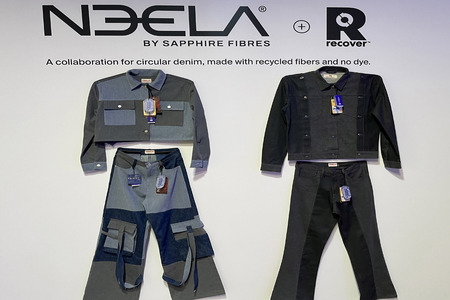
NDI India's largest denim maker lately caught Street’s fancy
YarnsandFibers News Bureau 2017-07-20 14:00:00 – MumbaiNandan Denim Limited (NDL), India's largest denim manufacturer and a little-known textile midcap, has lately caught the Street's fancy. Having completed its capacity expansion and backward integration, NDL looks set to garner market share in the post-GST regime as unorganized players grapple with the reality of new taxes.
Denim fabric contributes 80-90 percent to NDL's annual turnover on an average, is the company's forte.
NDL’s fabric manufacturing capacity, which stood at 99 million metres per annum (mmpa) at the start of FY17, increased to 110 mmpa in December 2016, post expansion. Going forward, emphasis will be laid on fashion denim fabric to target better realizations compared to regular denim material. A combination of higher sales volumes and value added products is likely to fuel top-line growth in the coming fiscals.
NDL more than doubled its spinning capacity from 64 tonnes per day (TPD) in FY16 to 141 TPD by the end of FY17. This will ensure adequate availability of yarn for the company’s fabric manufacturing unit, besides reducing the degree of dependence on outside suppliers for raw material and facilitating margin accretion.
NDL’s shirting fabric facility (annual capacity of 10 mmpa), which handled manufacturing of grey shirting fabric until now, has been equipped to manufacture superior variants. The average selling price per metre of the new fabric type is 60-400 percent higher vis-a-vis grey shirting fabric, which was previously sold at around Rs 100 per metre.
Simultaneously, a new yarn dyeing plant was commissioned during the recently concluded fiscal to meet input requirements of the shirting fabric department. The costlier dyed yarn (in comparison to non-dyed) would consequently help the company to command a premium pricing on its shirting material, eventually causing margins to go up.
Post GST implementation, the key raw material cotton for NDL, is at par with the pre-GST tax scenario, thereby keeping input procurement costs stable.
India’s denim market is clocking a consistent CAGR of 15-18 percent per annum and is expected to register a retail value of $361 billion by 2020 from the current level of $177 billion. Versatility of denim fabric, presence of numerous denim varieties across the country at different price points, better fashion consciousness, booming e-commerce retailing channels, higher disposable incomes, and geography-agnostic use are some of the other major industry drivers that NDL could possibly capitalize on.
Internationally, the denim industry is expected to grow at a CAGR of over 6.5 percent till 2020, with Latin America and Asia being the front-runners in the premium and super premium segments.
Of late, China, India’s biggest rival in the textile space, has been losing its export advantage, particularly to Indian entities, because of higher labour and compliance costs, in addition to declining cotton output (on account of increasing attention towards other cash crops). Evidently, a huge market awaits India’s denim products.
Y17 was a challenging year for NDL on many fronts. While a surge in cotton prices led to margin compression, the company’s top-line suffered a setback in the immediate aftermath of demonetisation, too. The expanded capacity didn’t yield revenues in the first nine months of the year.
With cotton prices now stabilizing (owing to an upswing in acreage pan-India) and capacity additions over, the company can look forward to gaining some momentum in terms of its earnings. NDL is gradually steering the business towards the value added denim category, unfavourable cyclical fluctuations associated with commoditized denim (that occupies a sizeable share of the company’s product portfolio) could impact margins.
Market Intelligence
Ask for free sample Report

experience
Customer Base
dedicated team
Countries Served Worldwide









